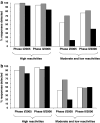The CIMT-monitoring panel: a two-step approach to harmonize the enumeration of antigen-specific CD8+ T lymphocytes by structural and functional assays
- PMID: 17721783
- PMCID: PMC2150627
- DOI: 10.1007/s00262-007-0378-0
The CIMT-monitoring panel: a two-step approach to harmonize the enumeration of antigen-specific CD8+ T lymphocytes by structural and functional assays
Abstract
The interpretation of the results obtained from immunomonitoring of clinical trials is a difficult task due to the variety of methods and protocols available to detect vaccine-specific T-cell responses. This heterogeneity as well as the lack of standards has led to significant scepticism towards published results. In February 2005, a working group was therefore founded under the aegis of the Association for Immunotherapy of Cancer ("CIMT") in order to compare techniques and protocols applied for the enumeration of antigen-specific T-cell responses. Here we present the results from two consecutive phases of an international inter-laboratory testing project referred to as the "CIMT monitoring panel". A total of 13 centers from six European countries participated in the study in which pre-tested PBMC samples, synthetic peptides and PE-conjugated HLA-tetramers were prepared centrally and distributed to participants. All were asked to determine the number of antigen-specific T-cells in each sample using tetramer staining and one functional assay. The results of the first testing round revealed that the total number of cells analyzed was the most important determinant for the sensitive detection of antigen-specific CD8(+) T-cells by tetramer staining. Analysis by ELISPOT was influenced by a combination of cell number and a resting phase after thawing of peripheral blood mononuclear cells. Therefore, the experiments were repeated in a second phase but now the participants were asked to change their protocols according to the new guidelines distilled from the results of the first phase. The recommendations improved the number of antigen-specific T-cell responses that were detected and decreased the variability between the laboratories. We conclude that a two-step approach in inter-laboratory testing allows the identification of distinct variables that influence the sensitivity of different T-cell assays and to formally show that a defined correction to the protocols successfully increases the sensitivity and reduces the inter-center variability. Such "two-step" inter-laboratory projects could define rational bases for accepted international guidelines and thereby lead to the harmonization of the techniques used for immune monitoring.
Figures





Comment in
-
Toward the harmonization of immune monitoring in clinical trials: quo vadis?Cancer Immunol Immunother. 2008 Mar;57(3):285-8. doi: 10.1007/s00262-007-0379-z. Epub 2007 Aug 25. Cancer Immunol Immunother. 2008. PMID: 17721782 Free PMC article. No abstract available.
Comment on
-
Results and harmonization guidelines from two large-scale international Elispot proficiency panels conducted by the Cancer Vaccine Consortium (CVC/SVI).Cancer Immunol Immunother. 2008 Mar;57(3):303-15. doi: 10.1007/s00262-007-0380-6. Epub 2007 Aug 25. Cancer Immunol Immunother. 2008. PMID: 17721781 Free PMC article.
References
-
- Galon J, Costes A, Sanchez-Cabo F, Kirilovsky A, Mlecnik B, Lagorce-Pages C, Tosolini M, Camus M, Berger A, Wind P, Zinzindohoue F, Bruneval P, Cugnenc PH, Trajanoski Z, Fridman WH, Pages F. Type, density, and location of immune cells within human colorectal tumors predict clinical outcome. Science. 2006;313:1960. doi: 10.1126/science.1129139. - DOI - PubMed
Publication types
MeSH terms
Substances
LinkOut - more resources
Full Text Sources
Other Literature Sources
Research Materials

